Abstract
1. The hypothermic effect on unanaesthetized cats of tetrodotoxin injected I.V. or into the lateral cerebral ventricle was examined.
2. At an ambient temperature (Ta) of 22° C, tetrodotoxin given intraventricularly was over 400 times more potent in lowering body temperature (Tb) than when given I.V. The magnitude of the hypothermia was dose-dependent for both routes. Decreases in Tb as great as 6·8° C were induced by infusions or multiple injections of tetrodotoxin into the ventricle.
3. Tetrodotoxin also lowered Tb at Ta = 13, 30 or 35° C. Tachypnoea, which lasted for longer durations and which became more intense the higher the Ta, accompanied development of hypothermia. Shivering was observed only during recovery from hypothermia at 13° C.
4. During the tetrodotoxin-induced hypothermia, animals were still able to regulate against environmental thermal stresses.
5. EDTA disodium salt, leucocytic pyrogen and prostaglandin E1 antagonized the hypothermic effect of tetrodotoxin when they were administered during recovery from tetrodotoxin.
6. Activation of heat-loss mechanisms, and the absence of compensatory shivering during development of hypothermia after tetrodotoxin administration, plus lowering of Tb by tetrodotoxin at Ta above as well as below the thermoneutral temperature, indicate that lowering of the thermoregulatory set-point is the mechanism by which centrally or peripherally administered tetrodotoxin lowers Tb. Further evidence for set-point lowering after intraventricular administration of tetrodotoxin is provided by persistence of the ability to regulate against both heat and cold stresses during hypothermia. The possibility that the decrease in set-point could be due to the well known action of tetrodotoxin to block transient increases in membrane sodium ion conductance is discussed in terms of a recent hypothesis regarding ionic control of the thermoregulatory set-point.
Full text
PDF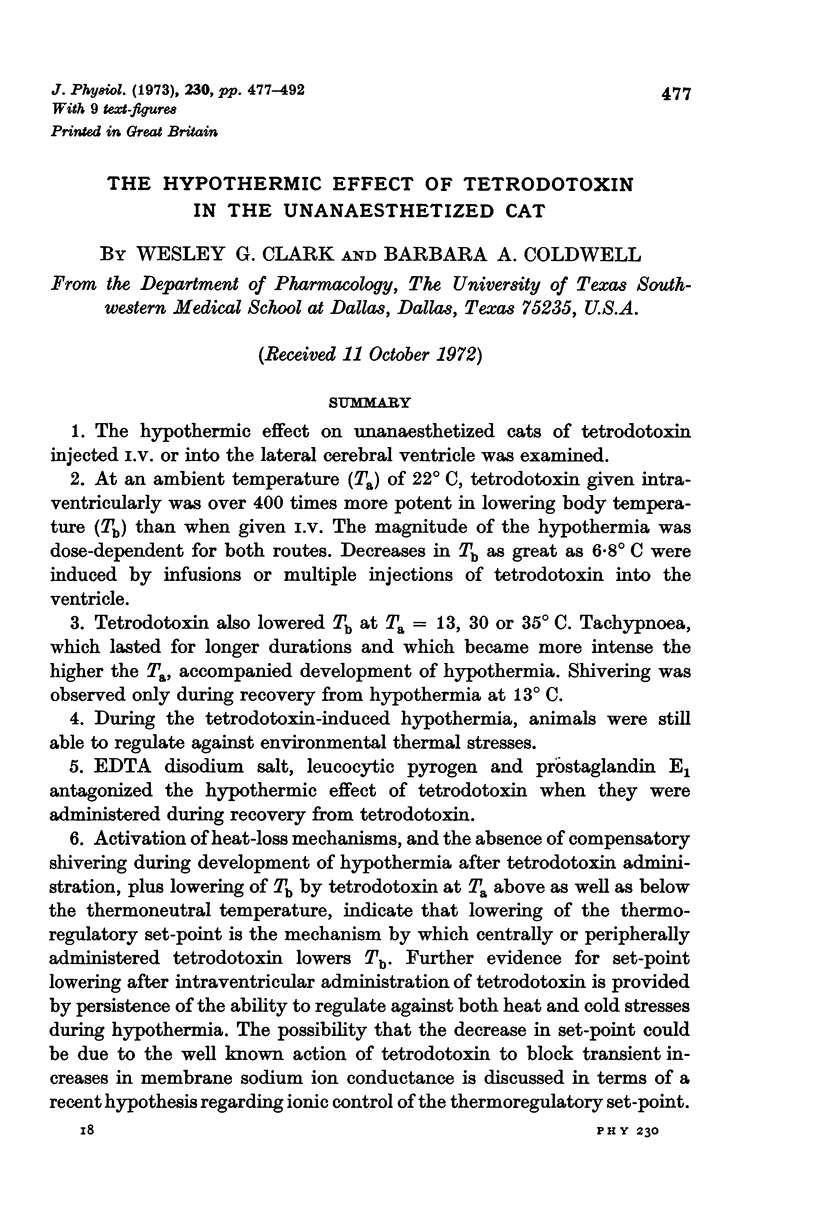

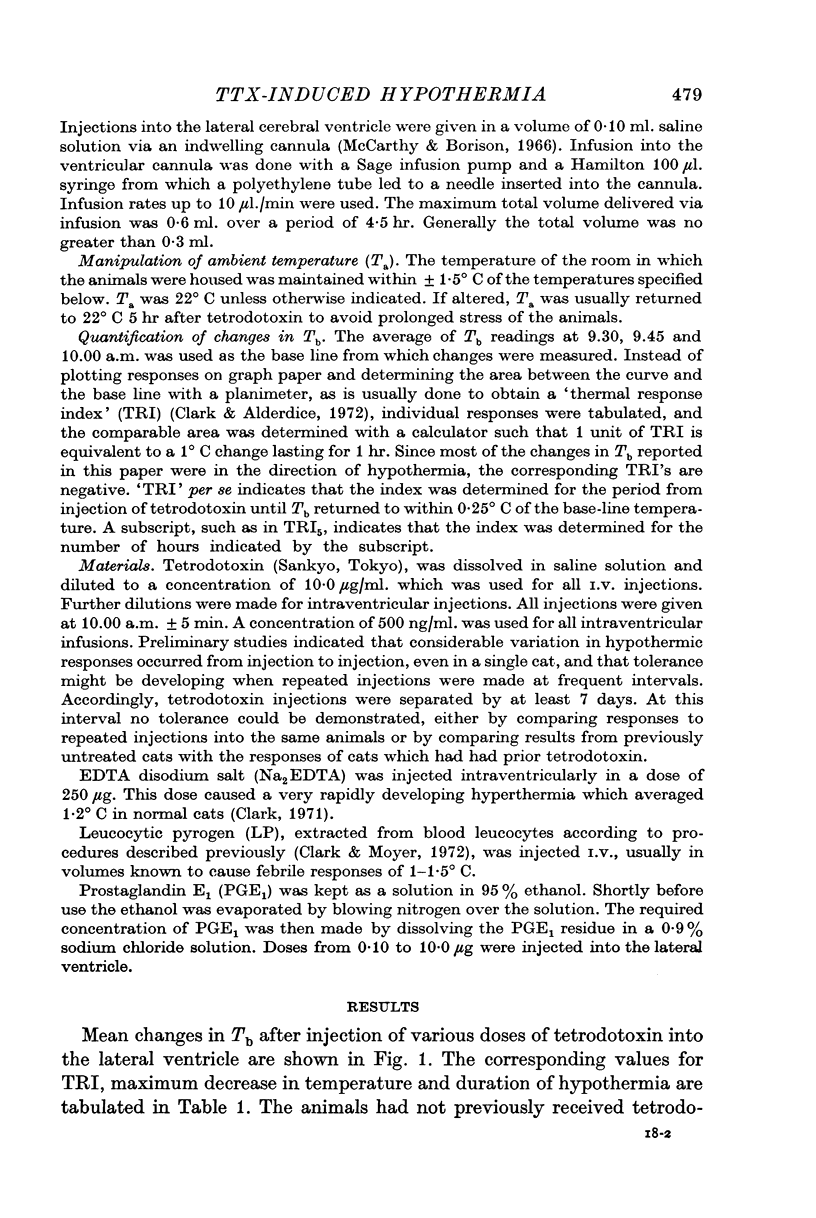

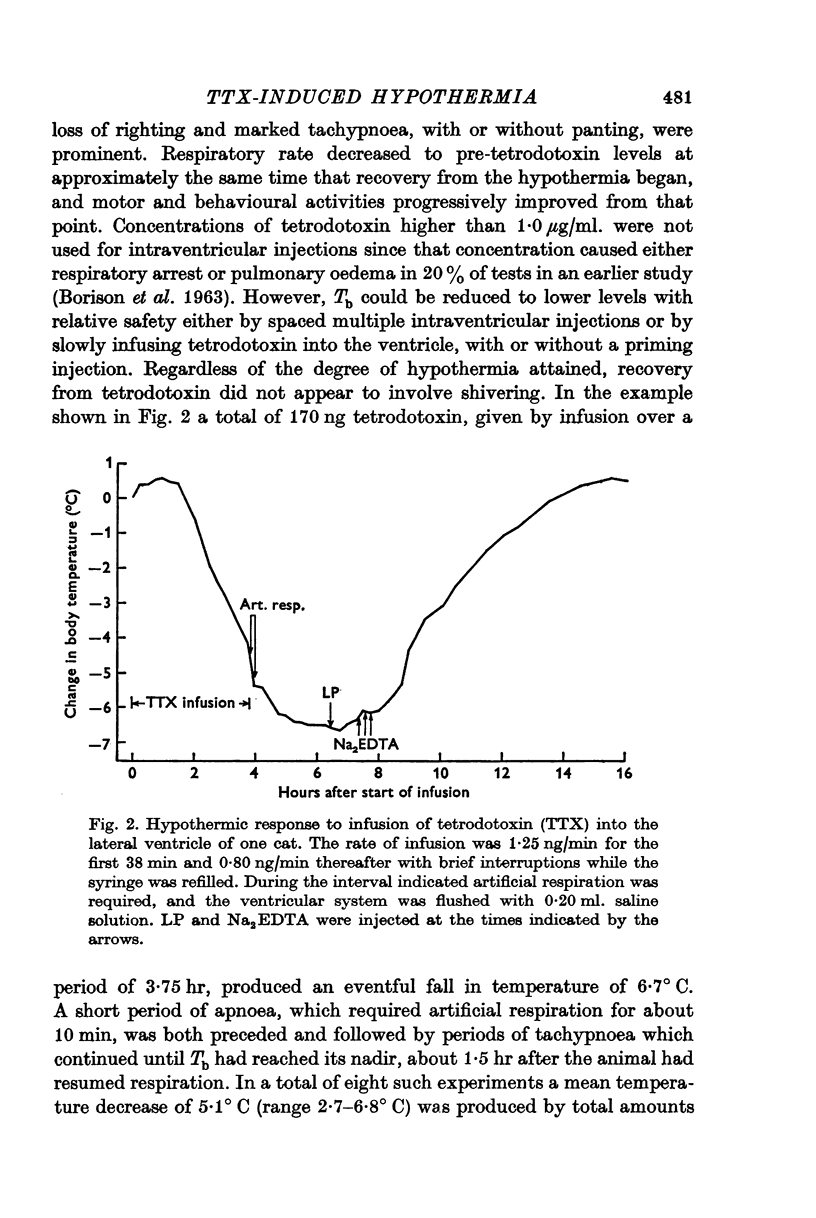
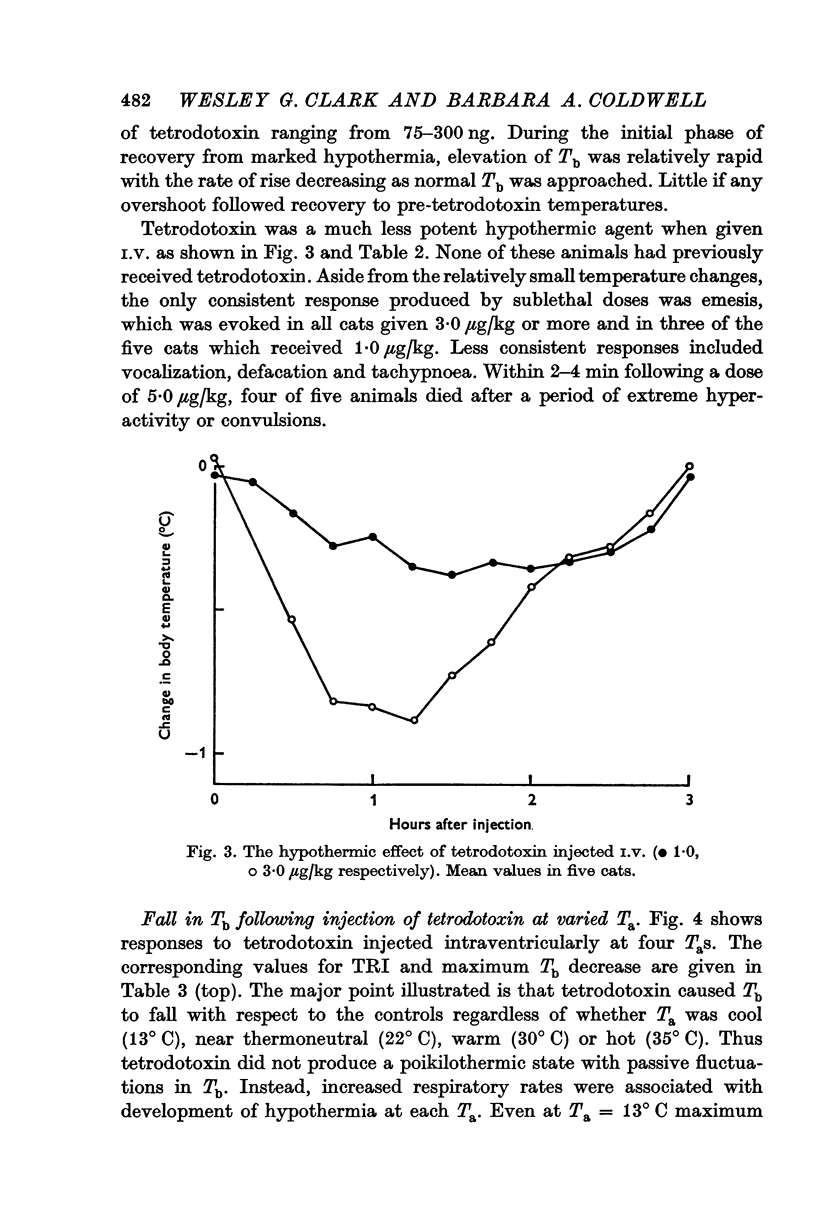
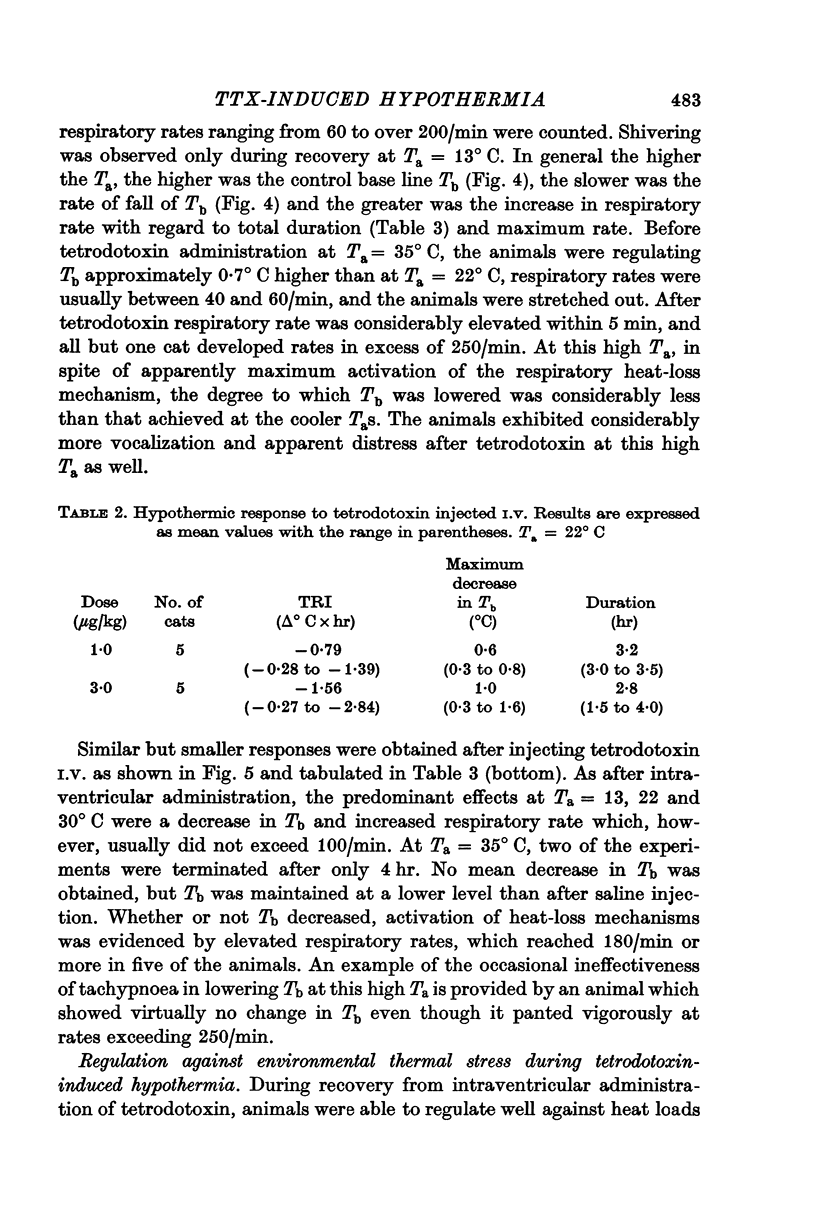
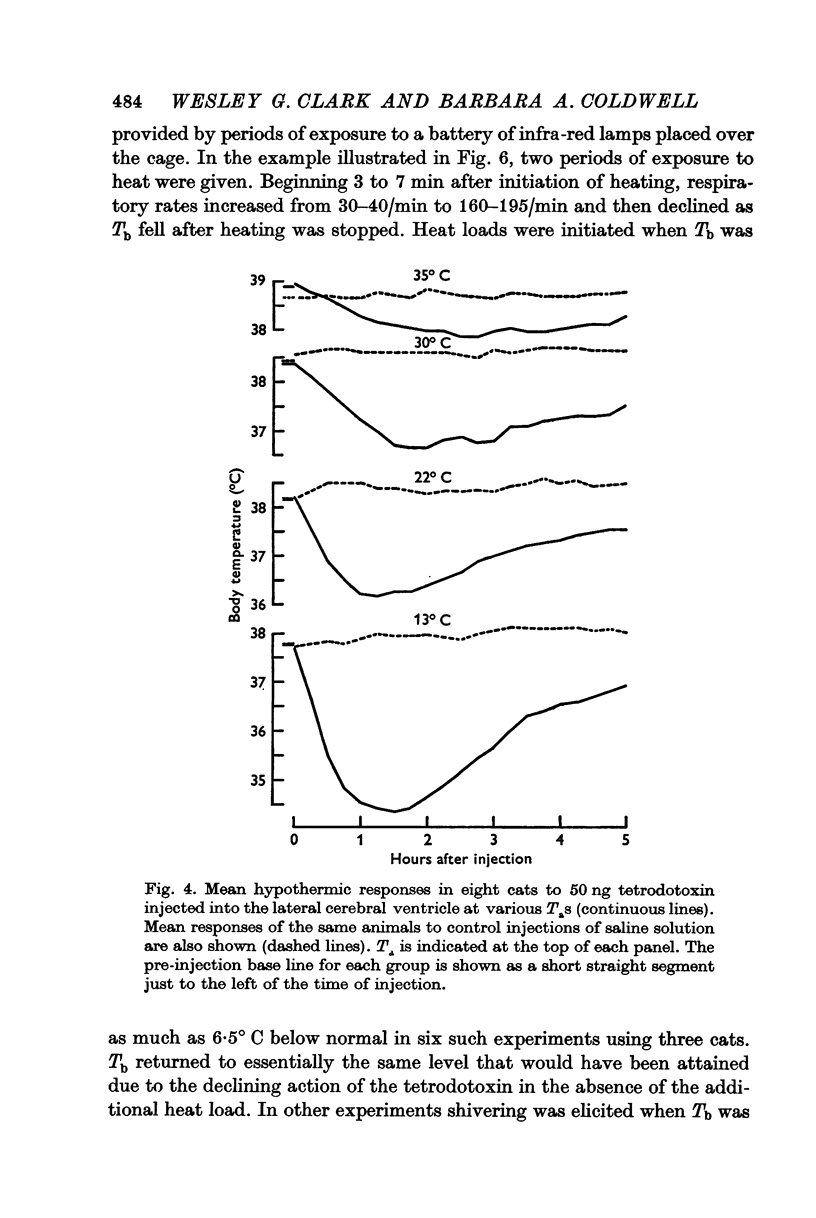
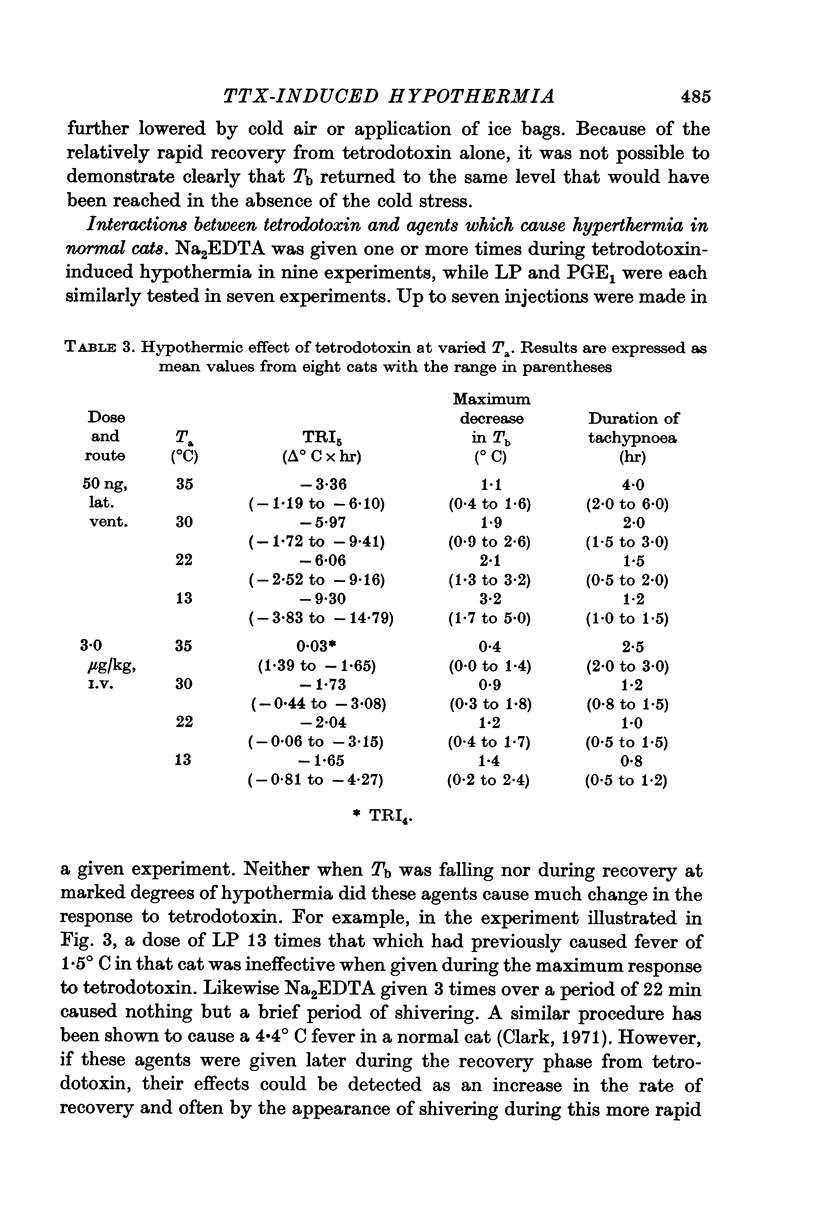
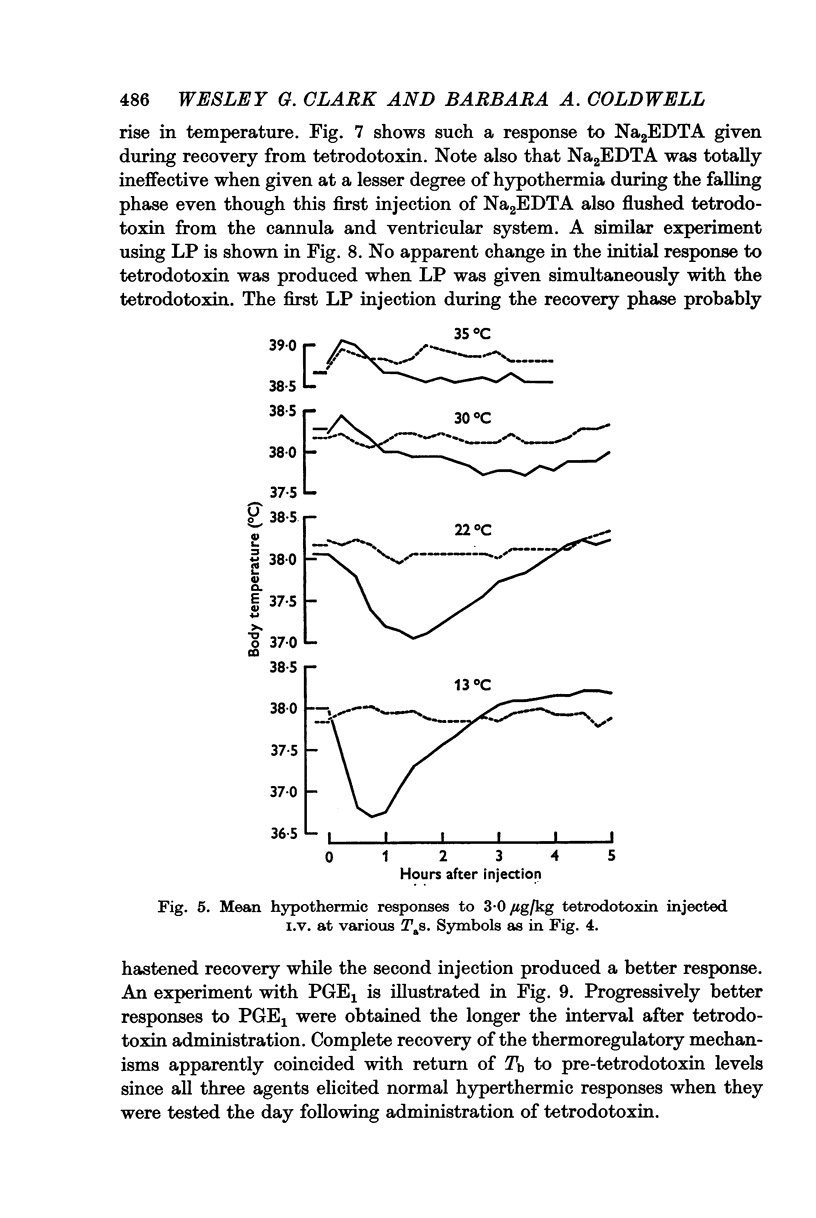



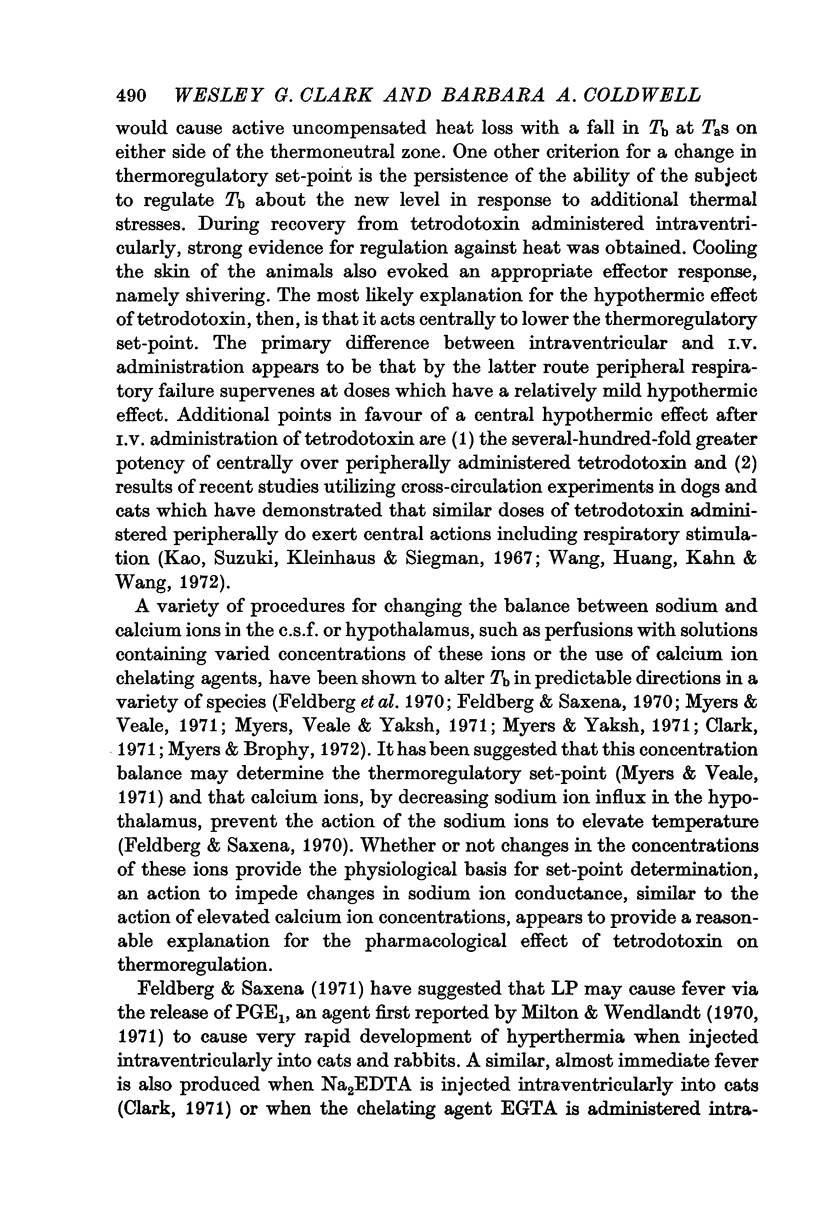

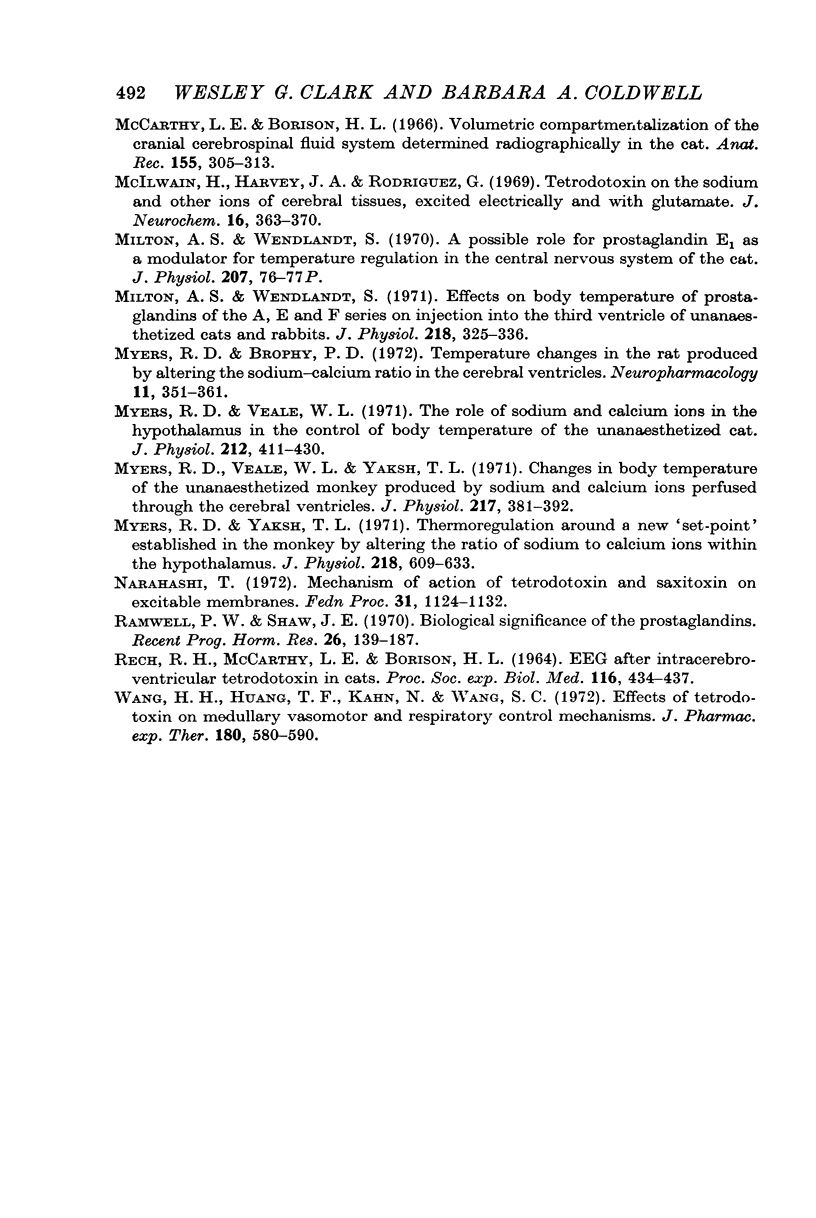
Selected References
These references are in PubMed. This may not be the complete list of references from this article.
- BORISON H. L., McCARTHYLE, CLARK W. G., RADHAKRISHAN N. Vomiting, hypothermia, and respiratory paralysis due to tetrodotoxin (puffer fish poison) in the cat. Toxicol Appl Pharmacol. 1963 May;5:350–357. doi: 10.1016/0041-008x(63)90094-2. [DOI] [PubMed] [Google Scholar]
- Borison H. L., Clark W. G. Drug actions on thermoregulatory mechanisms. Adv Pharmacol. 1967;5:129–212. doi: 10.1016/s1054-3589(08)60657-2. [DOI] [PubMed] [Google Scholar]
- Clark W. G., Alderdice M. T. Inhibition of leukocytic pyrogen-induced fever by intracerebroventricular administration of salicylate and acetaminophen in the cat. Proc Soc Exp Biol Med. 1972 Jun;140(2):399–403. doi: 10.3181/00379727-140-36467. [DOI] [PubMed] [Google Scholar]
- Clark W. G. Hyperthermic effect of disodium edetate injected into the lateral cerebral ventricle of the unanesthetized cat. Experientia. 1971 Dec 15;27(12):1452–1454. doi: 10.1007/BF02154285. [DOI] [PubMed] [Google Scholar]
- Clark W. G., Moyer S. G. The effects of acetaminophen and sodium salicylate on the release and activity of leukocytic pyrogen in the cat. J Pharmacol Exp Ther. 1972 Apr;181(1):183–191. [PubMed] [Google Scholar]
- FELDBERG W., MYERS R. D. TEMPERATURE CHANGES PRODUCED BY AMINES INJECTED INTO THE CEREBRAL VENTRICLES DURING ANAESTHESIA. J Physiol. 1964 Dec;175:464–478. doi: 10.1113/jphysiol.1964.sp007527. [DOI] [PMC free article] [PubMed] [Google Scholar]
- Feldberg W., Myers R. D., Veale W. L. Perfusion from cerebral ventricle to cisterna magna in the unanaesthetized cat. Effect of calcium on body temperature. J Physiol. 1970 Apr;207(2):403–416. doi: 10.1113/jphysiol.1970.sp009069. [DOI] [PMC free article] [PubMed] [Google Scholar]
- Feldberg W., Saxena P. N. Fever produced by prostaglandin E1. J Physiol. 1971 Sep;217(3):547–556. doi: 10.1113/jphysiol.1971.sp009585. [DOI] [PMC free article] [PubMed] [Google Scholar]
- Feldberg W., Saxena P. N. Mechanism of action of pyrogen. J Physiol. 1970 Nov;211(1):245–261. doi: 10.1113/jphysiol.1970.sp009277. [DOI] [PMC free article] [PubMed] [Google Scholar]
- Kao C. Y., Suzuki T., Kleinhaus A. L., Siegman M. J. Vasomotor and respiratory depressant actions of tetrodotoxin and saxitoxin. Arch Int Pharmacodyn Ther. 1967 Feb;165(2):438–450. [PubMed] [Google Scholar]
- McCarthy L. E., Borison H. L. Volumetric compartmentalization of the cranial cerebrospinal fluid system determined radiographically in the cat. Anat Rec. 1966 Jul;155(3):305–313. doi: 10.1002/ar.1091550304. [DOI] [PubMed] [Google Scholar]
- McIlwain H., Harvery J. A., Rodriguez G. Tetrodotoxin on the sodium and other ions of cerebral tissues, excited electrically and with glutamate. J Neurochem. 1969 Mar;16(3):363–370. doi: 10.1111/j.1471-4159.1969.tb10375.x. [DOI] [PubMed] [Google Scholar]
- Milton A. S., Wendlandt S. A possible role for prostaglandin E1 as a modulator for temperature regulation in the central nervous system of the cat. J Physiol. 1970 Apr;207(2):76P–77P. [PubMed] [Google Scholar]
- Milton A. S., Wendlandt S. Effects on body temperature of prostaglandins of the A, E and F series on injection into the third ventricle of unanaesthetized cats and rabbits. J Physiol. 1971 Oct;218(2):325–336. doi: 10.1113/jphysiol.1971.sp009620. [DOI] [PMC free article] [PubMed] [Google Scholar]
- Myers R. D., Brophy P. D. Temperature changes in the rat produced by altering the sodium-calcium ratio in the cerebral ventricles. Neuropharmacology. 1972 May;11(3):351–361. doi: 10.1016/0028-3908(72)90021-4. [DOI] [PubMed] [Google Scholar]
- Myers R. D., Veale W. L. The role of sodium and calcium ions in the hypothalamus in the control of body temperature of the unanaesthetized cat. J Physiol. 1971 Jan;212(2):411–430. doi: 10.1113/jphysiol.1971.sp009332. [DOI] [PMC free article] [PubMed] [Google Scholar]
- Myers R. D., Veale W. L., Yaksh T. L. Changes in body temperature of the unanaesthetized monkey produced by sodium and calcium ions perfused through the cerebral ventricles. J Physiol. 1971 Sep;217(2):381–392. doi: 10.1113/jphysiol.1971.sp009577. [DOI] [PMC free article] [PubMed] [Google Scholar]
- Myers R. D., Yaksh T. L. Thermoregulation around a new set-point' established in the monkey by altering the ratio of sodium to calcium ions within the hypothalamus. J Physiol. 1971 Nov;218(3):609–633. doi: 10.1113/jphysiol.1971.sp009636. [DOI] [PMC free article] [PubMed] [Google Scholar]
- Narahashi T. Mechanism of action of tetrodotoxin and saxitoxin on excitable membranes. Fed Proc. 1972 May-Jun;31(3):1124–1132. [PubMed] [Google Scholar]
- RECH R. H., MCCARTHY L. E., BORISON H. L. EEG AFTER INTRACEREBROVENTRICULAR TETRODOTOXIN IN CATS. Proc Soc Exp Biol Med. 1964 Jun;116:434–437. doi: 10.3181/00379727-116-29271. [DOI] [PubMed] [Google Scholar]
- Ramwell P. W., Shaw J. E. Biological significance of the prostaglandins. Recent Prog Horm Res. 1970;26:139–187. doi: 10.1016/b978-0-12-571126-5.50008-x. [DOI] [PubMed] [Google Scholar]
- Wang H. H., Huang T. F., Kahn N., Wang S. C. Effects of tetrodotoxin on medullary vasomotor and respiratory control mechanisms. J Pharmacol Exp Ther. 1972 Mar;180(3):580–590. [PubMed] [Google Scholar]


